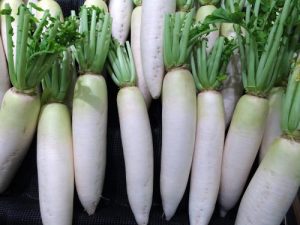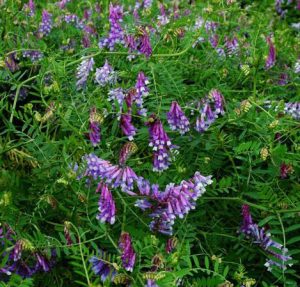Not Just for Farmers: Cover Crops
By Janet Scheren, Fairfax Master Gardener

Rye
If you think ground covers are a topic just for farmers, think again. Cover crops, also known as green manures, can provide multiple benefits for your home garden. Their basic function is to maintain the healthy biology of your soil at times you don’t have other active roots and plants growing. This continues the cycle of capturing sunlight, feeding essential soil organisms, sequestering carbon, trapping and recycling nutrients to enrich soil quality and maintaining soil structure.
Specifically, cover crops help you maintain and build the healthy biology of your soil throughout the year. Having roots in the soil feeds the bacteria that build soil aggregates. It also feeds the fungi, which use these aggregates to create macropores in the soil and increase permeability. These two biological processes reduce compaction and allow successive crops to have deeper, healthier roots. Having a robust soil structure also increases the availability of soil water by allowing rain and irrigation to soak in deeply and be retained if there’s sufficient organic matter, thus buffering the garden from variable weather. Maintaining roots in the ground all year long also helps to prevent soil and wind erosion and suppresses weed growth.

Daikon Radishes
If used strategically, cover crops can act like crop rotation to help break pest cycles. Specifically chosen cover crops can have an even more potent affect by addressing specific pests and other problems in your soil. For example, planting leafy mustard as a winter cover crop where tomatoes were grown helps clean up southern root-knot nematodes, some worms and insects, as well as other soil-borne pathogens. This strategy is called biofumigation. Mustard and most other plants from the brassica family produce chemicals called glucosinolates. In most cases, these biofumigant plants are chopped and incorporated into the soil to release their inhibitory chemicals.
Other strategies include using legumes as cover crops to enhance soil nitrogen levels or growing cover crops with deep tap roots, such as daikon radishes, to help aerate the soil and pull minerals from deeper in the soil to the surface to benefit successive crops.
Additionally, cover crops provide many seasonal benefits. During the summer, they can shade the soil from direct sun and its excessive heat, while helping soil retain moisture. In the winter, in addition to keeping roots in the soil to maintain soil biology, they can also provide winter interest.
In our Mid-Atlantic Zone 7a climate, most home gardeners will have plenty of roots in the soil during the warm months of the year. Thus, cover crops become a more important focus in late summer and fall to prepare the garden for the winter.
Winter Cover Crops
Typically, winter cover crops are planted as early as mid-August but no later than mid-October. They need to germinate and become established before the first hard frost. They are left to grow until it’s time to remove them in late April or early May to plant the spring garden. Other cover crops, like buckwheat and white clover, are sown in the spring or summer to cover and improve bare soil.

Crimson Clover
| Crop Minimum Soil Temp for Crop Germination (°F) | |
| Spring Wheat | 37 |
| Barley | 40 |
| Rye | 41 |
| Oats | 43 |
| Alfalfa | 45 |
| Sugar Beets | 50 |
| Daikon Radish | 55 |
| Austrian Winter Pea | 41 |
Steps for Planting a Fall Cover Crop
It’s a good idea to plant a mix of cover crops. Not only does this avoid the problems associated with monocrops, but it also allows those cover crops most suited to your site to compete and thrive. Experienced agriculturalists and research scientists report that this strategy produces the best results because soil and weather conditions vary from year to year, and what worked best last year won’t necessarily produce the best results in successive years.
Combine legumes and non-legumes when possible. You might want to sow oats if this is your first time trying a cover crop or if you want to be able to plant early spring vegetables. Oats are killed by the first hard freeze, leaving a brown decomposing mat in spring. Winter rye is also a good strategy as it is easy to hand pull if needed to plant a spring crop. Flowering cover crops should not be allowed to go to seed. A good rule of thumb is to remove these when about one-third of the plants are in flower. This is the point where the plant will provide the greatest amount of biomass and nutrients to the soil. You can chop and drop them in your garden, mow them to the ground or remove and add them to your compost pile.

Hairy Vetch
To sow a cover crop while vegetable crops are still producing, remove mulch from around plants and rake the area smooth. Your cover crop will have a good start but will not interfere with current vegetable growth.
The seed must directly contact soil to germinate. You can broadcast the seed by hand or with a hand-held broadcast seeder, preferably before a rain, and gently rake seeds evenly into the soil. Be sure to press the seeds into the soil by walking on them.
Also keep in mind that any perennial or hardy bulbs (including onions, garlic and shallots as well as ornamental bulbs), provide the same function as ground covers. Hardy vegetables, those that can survive cold winter temperatures many years, including some brassicas, mustards and Asian greens, can provide winter soil coverage as well.
Cover Crops to Consider
There are many commercially available seed mixes to make it easier for the novice gardener, or you can mix and match your own blend. Here is a list of cover crops to consider:
Legumes
Crimson clover: sow in spring or fall, reseeding annual, tolerates some shade, bright red flowers attract pollinators
Field peas: sow early spring to summer, annual, tops can be harvested for edible shoots. Killed by hard frost.
Hairy vetch: sow in fall, perennial, will regrow in the spring
White clover: sow in spring to late summer, perennial, slow to establish
Austrian winter peas: Sow in fall, goes dormant over winter and regains growth as temperatures warm in spring
Non-Legumes
Annual ryegrass: sow in spring to late summer, annual
Buckwheat: sow in spring, annual, grows quickly
Oats: sow in spring or late summer, annual
Tilling radish: sow in fall, fast-growing, taproots reduce compaction
Winter rye: sow in late summer, perennial
Winter wheat: sow in fall, hardy annual
The lessons learned from groundcovers — having a mix of roots in the ground all year long to promote good soil health — can also be extended to encourage healthy ornamental beds. Layering spring bulbs with annuals, perennials and shrubs in your landscape beds is a great way to enhance their biology and bioactivity and to enhance soil and plant health.
Resources
• Soil Temperature Maps, Green Cast Sygenta
• Grow Great Virginia Vegetables, by Ira Wallace
• Cover Crops, Jon Traunfeld, Reviewed by Raymond Weil, University of Maryland Extension
• Improve Vegetable Garden Soil with Cover Crops, Valerie Vaughan Sesler, Penn State Extension
• Cover Crops and Soil Health, USDA, Natural Resources Conservation Service
• Growing Mustard for Biofumigation, Alberta, Canada, Agriculture, Aquaculture and Fisheries
• Growing Guide: Radishes, Cornell University
… updated 2023